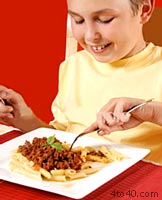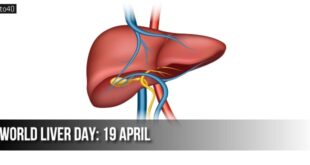 Deciding what’s for dinner (or breakfast, lunch, or snack) has never been more challenging. With childhood obesity, diabetes, and other food-related ailments in the news almost daily, you may wonder what you can feed your kids. The simple truth is, if you stock your pantry and fridge mostly with healthy options, you won’t have to think about it as much — and your children just might learn to love what’s good for them. Here, three food rules I recommend in my practice and live by with my own kids. They can help you build healthy eating habits for your whole family:
Deciding what’s for dinner (or breakfast, lunch, or snack) has never been more challenging. With childhood obesity, diabetes, and other food-related ailments in the news almost daily, you may wonder what you can feed your kids. The simple truth is, if you stock your pantry and fridge mostly with healthy options, you won’t have to think about it as much — and your children just might learn to love what’s good for them. Here, three food rules I recommend in my practice and live by with my own kids. They can help you build healthy eating habits for your whole family:
Eat the right carbs
With carbohydrate-conscious diet books still on the best-seller lists, and a friend dropping five pounds in two weeks on a bread-free regimen, it’s easy to assume that banishing carbs is good for your family’s health. It’s not. Like fuel for a car, carbs provide energy for bodies and brains. Children especially need lots of carbs, even more so when they’re very active.
But alas, not all carbs are created equal. Kid staples like mac ‘n’ cheese, pizza, and cookies are filled with empty carbs: refined (white) flour and/or too much sugar. The extra calories from all that sugar are turned into body fat. Plus, because empty carbs have few nutrients to slow down digestion, they’re quickly converted to glucose. They rush through the bloodstream and stomach too fast, leaving kids feeling hungry again. And that can lead to overeating.
It sounds scary, but the trick with carbs is to make sure your child gets enough of the right kinds, and not too much of the wrong ones. An easy rule of thumb: The best carbs come packed with fiber and some protein, and are close to how nature made them. The more processed they are (lots of ingredients you can’t pronounce is a sign), the worse they are.
Good carbs
- Fruits and vegetables
- Beans and lentils
- Tofu
- Whole grains
- Natural peanut butter, for kids over 4
- Low-fat milk and yogurt
- Oatmeal
Eat the right fats
 Many of the parents of my patients know that a diet high in fat can lead to health problems, but what many don’t realize is that fats help absorb the vitamins in food, help produce the hormones that regulate the body, and keep young skin looking young. (In fact, one of the main clues I look for that a child isn’t getting enough healthy fats is dry, flaky skin.) Little kids need them most: The brain, which depends on fat to function, does most of its growing in the first five years.
Many of the parents of my patients know that a diet high in fat can lead to health problems, but what many don’t realize is that fats help absorb the vitamins in food, help produce the hormones that regulate the body, and keep young skin looking young. (In fact, one of the main clues I look for that a child isn’t getting enough healthy fats is dry, flaky skin.) Little kids need them most: The brain, which depends on fat to function, does most of its growing in the first five years.
So your child needs a right-fat – not low-fat – diet. To make sure she gets it, limit saturated fats, found in red meat, poultry, and whole milk. Worst of all are the trans fats you’ve been hearing about lately (also called hydrogenated oils). They’re processed to last a long time, which is great for a box of Twinkies but really bad for the arteries. Also, beware of foods labeled “low-fat,” which often have lots of extra sugar to make them taste good.
The best way to increase good fats in your child’s diet is to serve more fish. Cold-water varieties like wild Alaskan salmon, sardines, pollock, and catfish have high levels of omega-3 (the superstar of good fats) and low levels of mercury, which is toxic to growing minds and bodies. Avoid mercury-rich shark, swordfish, king mackerel, and tilefish.
(Also, limit canned light tuna to six ounces per week, as some cans may have more mercury than is safe for kids, according to new research.) Your child won’t eat fish? I’ve heard this one countless times from parents, and I’ll tell you what I tell them: Prepare it different ways, and keep dishing it up — it’s worth it.
Good fats
- Fish
- Olive oil
- Nuts and seeds, for kids over 4
- Avocados
- Eggs
Don’t skip breakfast
Mornings are a crunch for all of us, but eating well is nonnegotiable in my house. Think of it this way: Would you set out on a road trip with an empty gas tank? That’s what your child is doing when she embarks on a day of play and learning without first fueling up. Eating breakfast helps kids stay sharp and behave better at school, and nutritious meals in the morning have been linked to better eating throughout the day.
The main ingredients for a healthy breakfast are proteins, good carbs (which have fiber), some good fats, and minerals, such as calcium, iron, and zinc.
Good breakfasts
-
Scrambled eggs, whole-wheat toast, and calcium-fortified orange juice
-
A veggie omelet, whole-wheat toast, a glass of low-fat milk
-
Peanut butter and banana slices on a whole-wheat English muffin with low-fat milk
-
Opt for cereals with at least three grams of fiber, five grams of protein, and no more than five grams of sugar per serving. Feeding your kids oatmeal? Good for you — even better if it’s the old-fashioned kind, which has less sugar and keeps kids fuller longer than instant. A mom of one of my patients cooks oatmeal overnight in a slow cooker, then tops it off with her child’s favorite fruit.
These three changes are a great place to start in healthy eating. If you fill your child’s life with these good habits, the rest will come easy.
 Kids Portal For Parents India Kids Network
Kids Portal For Parents India Kids Network






